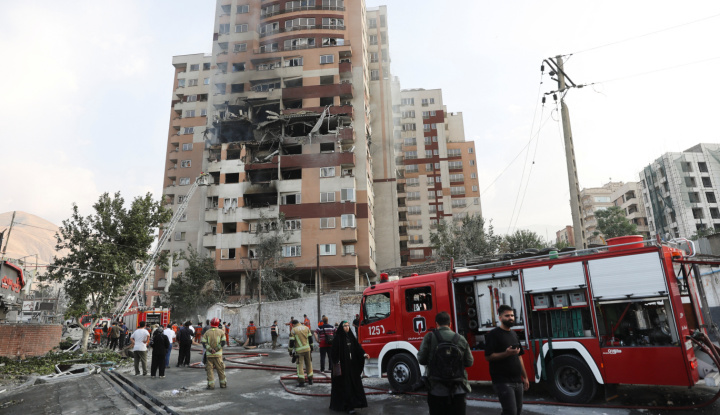Firefighters work at the scene of a damaged building in the aftermath of Israeli strikes, in Tehran, Iran, June 13, 2025. Photo: Majid Asgaripour/WANA (West Asia News Agency) via REUTERS
Below is a troubling timetable of how the media reported the first few days of the war between Israel and Iran:
Thursday, June 12 – Friday, June 13: A Multi-Pronged Assault to Cripple Iran’s Nuclear Program
In the early hours of Friday, June 13, Israel launched Operation Rising Lion, a sweeping, coordinated offensive against Iran’s nuclear infrastructure and the officials overseeing it.
The operation marked a decisive move against the Islamic Republic’s military capabilities, unfolding as a bold, surgical campaign whose execution appears to have been years in the making, with final preparations reportedly completed during the past eight months.
The IDF, Mossad, and Israel’s defense industries collaborated on a meticulously synchronized, three-pronged assault deep inside Iranian territory.
In the hours before the strike, the global media fixated on rising tensions following a damning report from the UN’s International Atomic Energy Agency (IAEA), confirming Iran’s violation of key non-proliferation obligations. In defiance, Tehran responded not with restraint, but with escalation, announcing a new uranium enrichment facility and the activation of advanced centrifuges designed to accelerate weapons-grade production.
Despite Israel’s patience and precautions and Iran’s brazenness, much of the international media framed Israel’s actions as destabilizing.
Media Briefings, Misdirection, and a Green Light
The media’s false judgment of Israel relied on reports that President Donald Trump had urged Israeli restraint in the days leading up to the assault, preferring renewed nuclear diplomacy.
CNN reported that Trump had warned Prime Minister Netanyahu to “stop Iran threats,” claiming the US was “ramping up pressure” on Israel to hold off on any military action.
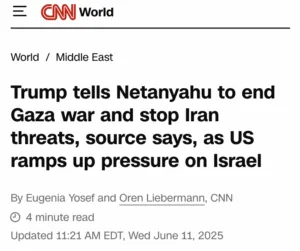
The New York Times echoed this, framing Israel as “ready to attack Iran” in a move that could, they claimed, “further inflame” the region and derail US diplomacy.
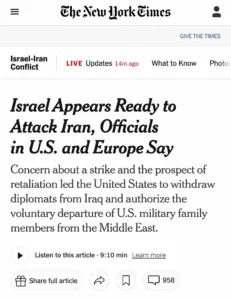
The Washington Post ran with the headline “Fears of an Israeli Strike on Iran,” citing unnamed US intelligence officials who were “increasingly concerned” that Israel would act “without the consent of the United States,” a move they claimed would doom diplomatic efforts and provoke Iranian retaliation against US assets in the region.
Oddly, those same outlets also reported Iranian threats, including a warning by Defense Minister Aziz Nasirzadeh that it could strike US bases if talks collapsed — yet these were treated with far less alarm.
What none of the reporting made clear at the time, but has since been confirmed, is that these supposed leaks and briefings about US reluctance were part of a coordinated misdirection campaign designed to mislead Tehran.
In an interview with Reuters on Friday, President Trump pulled back the curtain: “We knew everything,” he said, calling the Israeli strikes “excellent” and “very successful.” Israeli officials confirmed the US had been briefed in advance and had given quiet approval, though it withheld direct military support.
Friday, June 13: Media Cries “Rogue Israel” Before Iran Responds by Targeting Civilians
Despite the confirmation from Trump, much of the media clung to the narrative of a defiant, unilateral Israel.
CNN’s Kevin Liptak, for example, published an analysis claiming Israel had “ignored direct warnings” from Trump and acted without US involvement, describing the strikes as “against the president’s publicly stated wishes.” The irony, of course, is that these “publicly stated wishes” were never meant to reflect the truth — they were part of the ruse. Liptak, like many others, appeared to mistake strategic misdirection for a diplomatic breakdown.
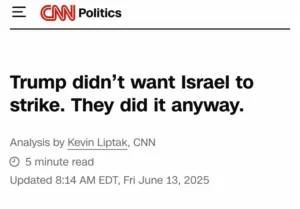
The Conversation published a breathless analysis accusing Israel of “defying Trump” and “risking a major war.” One is left to wonder: what exactly does The Conversation consider a risk? Iran stockpiling enriched uranium, threatening regional annihilation, and publicly vowing to strike Israel apparently doesn’t meet their threshold. Only Israel’s preemptive attempt to stop it does.
Bloomberg took a similar line, claiming Israel had “expressly disregarded the wishes of Trump” — even as Trump himself, just hours later, confirmed US foreknowledge and praised the mission’s success.
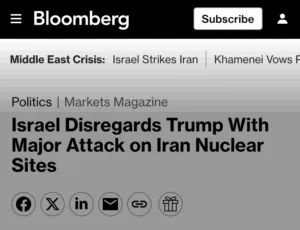
At approximately 9:00 p.m. Friday, Iran responded, not with a measured military reply, but with indiscriminate missile barrages targeting civilian centers.
And yet, media coverage remained locked on the same refrain: that Israel was the destabilizing party, even as missiles rained down on apartment buildings, while the regime responsible for launching them was portrayed as merely the victim of someone else’s war.
Saturday, June 14 – Sunday, June 15: Israel Continues, and Iranian Missiles Kill More Civilians
Operation Rising Lion continued through Saturday, with US officials reportedly assessing the strike on Iran’s Natanz nuclear facility as “extremely effective.” On June 14, Israel expanded its campaign, targeting weapons sites and critical energy infrastructure, aiming to degrade Iran’s ability to fund, fuel, and sustain its nuclear and military operations.
Once again, the Iranian regime responded not with military countermeasures, but with another wave of indiscriminate missile attacks on Israeli population centers — Bat Yam, Rishon Lezion, and Haifa.
And yet, this simple fact — this fundamental asymmetry — has been ignored, downplayed, or erased by many in the global media.
This is not a war between two belligerent nations targeting one another’s cities. It is a preemptive strike by a democracy against the world’s most prolific state sponsor of terrorism, and the inevitable response from that regime: the mass targeting of Israeli civilians, just as it has always promised to do.
The New York Times, which has devoted entire front pages to Gazan casualty figures, often sourced solely from Hamas, could not find space for a single headline acknowledging Israeli deaths. Not one. An entire homepage dedicated to the war, and no room for Israeli victims.
10 Israelis are dead. 200 are injured.
But you won’t see that in any @nytimes headlines today.
Because Israeli casualties evidently don’t count for The New York Times. pic.twitter.com/56jpVqwhAz
— HonestReporting (@HonestReporting) June 15, 2025
The Washington Post, The Guardian, and wire services like AFP have leaned heavily on the language of equivalency — describing “trading strikes,” “tit-for-tat attacks,” and an “exchange of missiles.”
What they omit is that one side (Israel) is striking military targets. The other (Iran) is deliberately targeting children in their homes.
This is not two sides “trading strikes.”
While Israel targets the Iranian regime, the Islamic Republic fires its missiles at Israeli civilians.
Enough with the moral equivalence, @washingtonpost. pic.twitter.com/cUxjPJP8ZX
— HonestReporting (@HonestReporting) June 15, 2025
The Guardian even speculated that Israel might expand its operations “beyond” the nuclear program, ignoring that Israel has been transparent about its objectives and precise in how it has carried them out.
Newsweek accused Israel of “escalating” the conflict for conducting precision strikes on underground nuclear facilities and weapons depots — but didn’t say anything about Iran, which launched ballistic missiles at apartment buildings.
The Context Matters
Yes, Israel struck first –but this was a preemptive strike against a regime that has made no secret of its ambition to destroy the Jewish State.
Just two days before Israel acted, the United Nations confirmed Iran was violating its nuclear obligations and moving closer to weapons-grade enrichment. Tehran responded by threatening to attack US forces in the region.
This is the same regime that funds and arms terrorist proxies across the Middle East: Hamas, Hezbollah, and the Houthis — all of which have escalated attacks on Israel since October 7, 2023, and all of which are also openly committed to Israel’s destruction.
It is also the same regime that has targeted Western civilians. In 2022, the head of the UK’s MI5 revealed that British authorities had foiled more than 20 Iranian-backed plots targeting UK citizens. These plots, he said, frequently involved Iran’s use of international criminals as proxies — a tactic seen across Europe.
View this post on Instagram
The Bottom Line
This war was not inevitable. It was engineered by a regime that has spent decades plotting Israel’s destruction, funding terror across the region, and defying every international safeguard against nuclear proliferation.
Israel’s strike was not reckless. It was necessary, strategic, and aimed entirely at military infrastructure and personnel. Iran’s response, true to form, has been to fire missiles indiscriminately at Israeli civilian centers.
Yet much of the global news media has recast this as a clash between moral equals, drawing a false equivalence that erases the line between aggression and defense, between terrorism and counterterrorism.
The world’s most dangerous regime is watching closely to see whether its atrocities will be condemned or excused. And thanks to most of the media, it may already have its answer.
The author is a contributor to HonestReporting, a Jerusalem-based media watchdog with a focus on antisemitism and anti-Israel bias — where a version of this article first appeared.
The post Big Surprise: The Media Uses Its Platform to Side with Iran’s Terrorist Regime Over Israel first appeared on Algemeiner.com.
Click this link for the original source of this article.
Author: Rachel O’Donoghue
This content is courtesy of, and owned and copyrighted by, https://www.algemeiner.com and its author. This content is made available by use of the public RSS feed offered by the host site and is used for educational purposes only. If you are the author or represent the host site and would like this content removed now and in the future, please contact USSANews.com using the email address in the Contact page found in the website menu.

